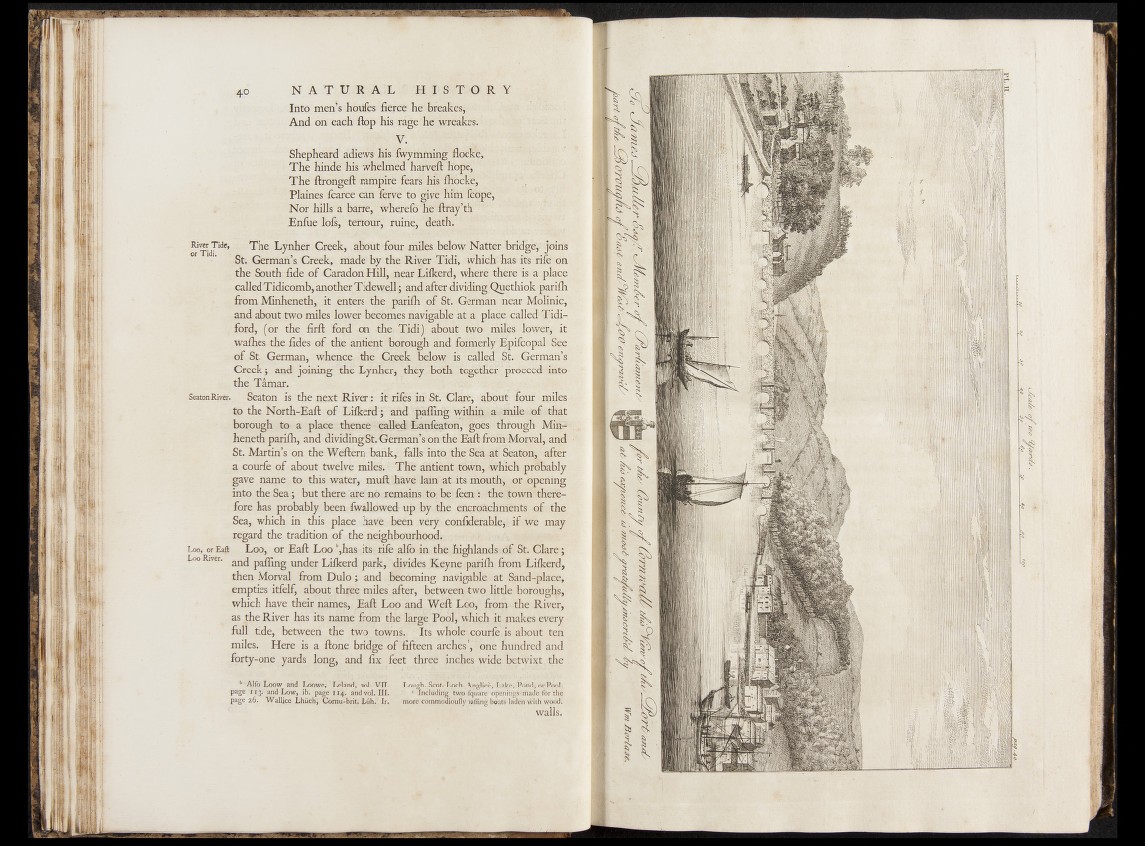
It ê
1 1 1
it 1111
40 N A T U R A iL-'i H K S fX i O R Y
Into men’s houfes fierce- hè bfeakesj -
And on each- flop his. rage; he wreakes. 1|||H
Shepheard adiews his fwymming.flodre,'
The hinde Ms whbltnèd harveft hope,
The ftrongeft Tampirè fears1 his mbck<é, ' ' *",
Plaines fcarce can ftrve to givfehi'm' fcope,
Nor hills a ' barre, i^h«^feföii6'iffifiay’th
Enfiie lofs, terrour, ruiné?' death.
Ri'rJ'ide* The Lynher Creek, about foto nnlfeS bdow, NatterJtrfd^-jöihs
m vSfe German’s Creek, made; by the Riyer Tidi, which-ha&És rifeToö
the South fide of Caradon Hill, mear Lifkerd, where there is a place
called Tidicomb, another Tidewell ; and after dividing Quethiok parifh
from Minheneth, it enters the parifh of St. German near Molinic,
and about two miles Iowa becomes navigable at a. plaGe,’called«Pidi-
, ford, (or the firft fbrd on the. T jd ia b o u t two miles lower, it
wafhes the fides of the antient 'borough and formerly Épifcopal ,%jpe
o f St. German, whence the Creek below is/ called! Jt.,' German’s
Creek; and joining the Lynher, they both togethèr(.proceed^ntp
. the Tamar.
Seaton River. Seaton is the next River; it-riles inSt.'Clare, about-four miles-
to the North-Eaft o f Lifkerd; and paffirig within a rümile . ©fot-hat
borough to a place thence called Lanfeaton, gres Through Min^
heneth parifh, and dividing Sf.-German’s4pn‘fhe Eaft froih-Morval, and
St. Martin’s on the Weftern bank, falls into the; Sèa- at’ Seaton* after
a courfe of about twelve miles, f TKe antient town, which probably
gave name to this water, muft have lain at,its mouth, ©reopening
into the Sea; but there are'no-remains toi berjfeenf’i' th row n therefore
has probably been fwallowed-up byi the emGrottófrrrfèïits of the
Sea, which in this place have been very. ce>nfiderable,-i iftilye may
regard the tradition o f the neighbourhood.
Loo, orEaft Loo, or Eaft Loo",has its rife alfe in the . highlands \df St. Clare;
^°°River' and palling under Lifkerd park, divides Keyne parifh from Lifkerd,
then Morval from Dulo; and becoming navigable .at Sand-place,
empties itfelf, about three miles after, between two little boroughs,
which have their names, Eaft Loo and Weft Loo, from the River,
as the River has its name from the large Pbol, which it makes every
full tide, between the two towns. Its whole courfe is about ten
miles. Here is a ftone bridge of fifteen arches*, one hundred and
forty-one yards long, and fix feet three inches wide Ipetvyixt the
b‘Alfo Loow and Loowe, Leland, vol.VII.
page 113.' and Low, ib. page 114. and vol. III.
page 26. Wallice Lhiich, Cornu-brit, Lüh. Ir.
Lough. Scot. Loch, Anglice, Lake, Pond, or Pool,'
c Including tw;o fquare openings;made for the
more commodioully palling boats laden with wood;
walls.
1